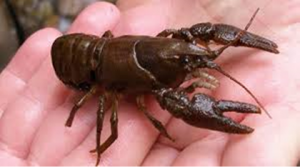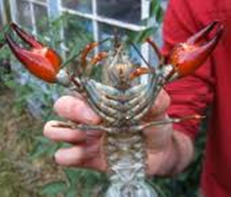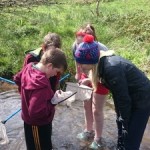Rivers trusts are charities, established by local people to look…
Crayfish plague in Lough Gowna Catchment, Cavan
Crayfish background
For those who aren’t already aware of their existence, crayfish are native to Irish lakes, rivers, streams and canals. They are the only member of the lobster family living in our freshwaters. They grow to approximately 10-15cms in length and have large sharp claws for defence and feeding. They require water with high calcium concentrations in order to maintain and grow their hard shells, so are typically found in limestone regions. Ireland has only one species, the White Clawed Crayfish (Austropotamobius pallipes) and large populations can be found in many areas.

They are mainly nocturnal and seek refuge under stones, logs and vegetation where they enjoy a varied diet of insects and plants. They are known to be cannibalistic, particularly the larger adults. They can survive for up to ten years and are important prey items for otters, fish and birds on our waterways.
Historically found across most of Europe, White Clawed crayfish populations have seen massive declines in the last hundred years – to the point where it is now extinct in many parts of Europe. This global decline can be attributed to many issues –habitat destruction, pollution, overfishing- but primarily to competition from non-native species, particularly the North American Signal Crayfish (Pacifastacus leniusculus,). The Signal Crayfish was introduced across Europe for aquaculture (it is much bigger then the native species) but escapees, and its use by fishermen as bait, has led to its rapid establishment across most of the white-clawed range. Being bigger and more aggressive, the Signal Crayfish outcompetes the native species for habitat and food (much like the grey squirrel outcompetes the native red squirrel) restricting it to isolated areas and resulting in large population declines. Most worrying of all, the Signal crayfish is a carrier of the crayfish plague, which it is immune to –but the native species has no immunity at all. The plague is a fungal infection (Aphanomyces astaci) which spreads rapidly and leads to total wipeout of infected individuals within two weeks of exposure. While the Signal crayfish is the original source of the infection, the fungal spores can then be carried by other animals (otters/mink/migrating birds etc) into new watercourses. The transfer of boats between river/lakes and the movement of watersport enthusiasts and fishermen are thought to transmit the fungus. Once the actual fungus is introduced into a waterway, it spreads quickly and without assistance. The natural movement of the water will transport the spores downstream and infected crayfish will move the disease upstream. Terrestrial animals, bathing, fishing and boating activities will also accelerate the diffusion of the plague driving our native crayfish to the brink of extinction. The disease is rapid and fatal, with few clinical symptoms. Often the only evidence of its presence is the appearance of hundreds or thousands of dead and dying crayfish on the lake shore or river bank. Infected specimens may exhibit unusual behaviour a few days before death, such as appearing during daylight hours, wandering out of the water and walking strangely due to paralysis. White tufts of fungus may or may not be visible on the body.
White Clawed Crayfish in Ireland
Only the native white clawed crayfish has been recorded in Ireland to date and as such we are unique in Europe in having no alien crayfish species present –yet. As a result, Ireland has the largest and most important remaining populations of white clawed crayfish in Europe, where it is listed as Endangered in the IUCN Red List of Endangered Species, and is also listed under Annex II of the EU Habitats Directive. Despite the absence of its competitor, the signal crayfish, crayfish plague has been confirmed in Ireland on several occasions since the 1980’s with some areas losing all their crayfish stocks (Lough Lene, Lough Bane, Lough Sheelin, Lough White (crayfish since reintroduced by NPWS), Lough Owel, parts of Inny catchment, parts of Boyne Catchment etc), the fungal spores suspected to come from infected nets, gear, boats or migrant birds. This latest confirmed outbreak in Co Cavan (on a tributary of the River Erne) has led to fears of the plague spreading rapidly and wiping out our remaining stocks of this protected native species.

What can we do
As responsible water-users, the most important thing we can do is limit the spread of the fungal spores. Crayfish plague spores can be spread on damp equipment such as fishing tackle, boots, canoes and machinery. Do not move any equipment that has been in contact with river or lake water without either disinfecting (iodine based disinfectant) or washing (clean tap water) and then drying completely. If you see any signal crayfish (see photo below) or anyone in possession of, or attempting to trap, release or sell live crayfish, please report to NPWS or IFI. Similarly, if you notice any numbers of dead/dying native crayfish please also report it.
Crayfish Plague (tips from BugLife UK)
Follow these simple tips and you can help to stop the spread of crayfish plague…
Definitely: – Dry all wet and muddy equipment used in rivers and lakes for several days
Try to: – Thoroughly washing all wet and muddy gear and then dry for several days
Or: – Disinfect with a suitable disinfectant (e.g. domestic bleach, an iodine-based disinfectant, FAM30, Virkon or others). Clean off any mud before using a disinfectant and make sure you dispose of the left over disinfectant carefully so it doesn’t cause any pollution to waters. Anglers try to avoid fishing different rivers or other water bodies on the same day, but if you do then disinfect all wet gear between sites. It helps prevent the spread of diseases and parasites of fish too. If there is an outbreak of crayfish plague in a river, avoid going into the water if at all if possible. When there are dead and dying White-claws the risk of spreading crayfish plague is hugely increased.






